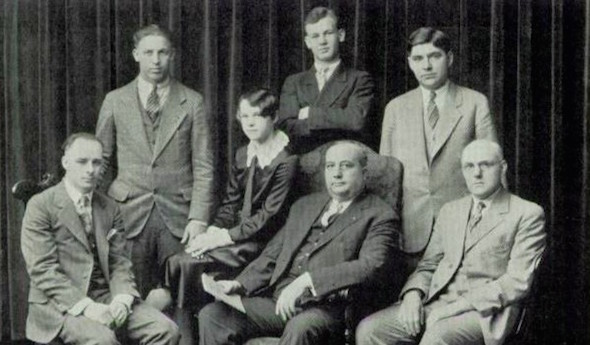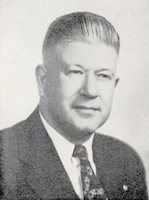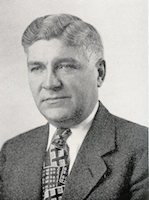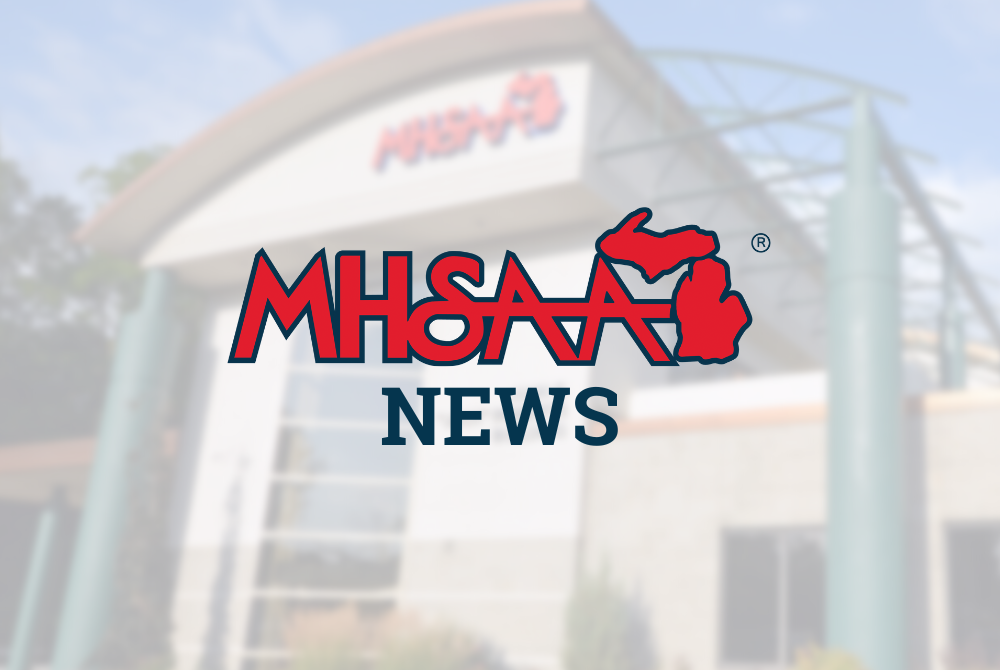
50 Years Later, 'Charlie' Remains Legendary
By
Ron Pesch
MHSAA historian
September 30, 2018
There is no official record of the proceedings, only a short newspaper recap of the event that was hosted 50 years ago at Michigan State’s Kellogg Center. In attendance was a who’s who of high school sports administrators. They were there to honor the man, affectionately known to his friends as “Charlie.”
A parade of guests presented gifts and citations, then sang his praises.
Dr. Clifford Fagan, Executive Secretary of the National Federation of High School Athletics, attended. State Directors of Athletics from Indiana and Ohio were on hand for the Monday, October 7, 1968, celebration.
Dr. Ira Polly, State Superintendent of Public Instruction, called him “noble, honest and courageous.” John F. Toepp, a state senator and radio sports broadcaster from the Cadillac area, “hailed him as ‘Mr. High School Athletics.’”
Sportswriter Bob Gross, six years into his career at the Lansing State Journal, wrote that Charles E. Forsythe, seated next to his wife Josephine, “only grinned with each word of gratitude.”
More than 350 friends attended the testimonial dinner, honoring the second director of the Michigan High School Athletic Association upon his retirement. For 39 years, Forsythe had served the MHSAA, dedicated to bettering the world of high school sports in Michigan and beyond. His years of service would formulate the mold for those who would follow in his footsteps.
“For five minutes they applauded,” wrote Gross, capturing the moment. Forsythe was humbled by the appreciation. When it was his turn to speak, he thanked the assembled crowd.
 “This is a great night. It’s just wonderful so many of you came to my party. I’m deeply honored,” Forsythe said. “I can’t stand here and accept all the thanks. It was teamwork that made our organization go. And, may I ask of all of you to please help make it grow bigger and better than it is.”
“This is a great night. It’s just wonderful so many of you came to my party. I’m deeply honored,” Forsythe said. “I can’t stand here and accept all the thanks. It was teamwork that made our organization go. And, may I ask of all of you to please help make it grow bigger and better than it is.”
The MHSAA had announced Forsythe’s retirement in late May.
With the exception of a 39-month tour as a Navy Commander, assisting former heavyweight boxing champion Gene Tunney in directing Navy physical fitness activities during World War II, Forsythe had been with the Association since July of 1929, originally as an assistant to Alden W. Thompson, the first director of the MHSAA. (Forsythe remains considered the Association’s first fulltime executive director.)
A graduate and prominent athlete at Milan High School, Forsythe earned his undergraduate degree from Michigan State Normal College (today’s Eastern Michigan University) in 1920 and his Master of Arts degree from the University of Michigan in 1926. He coached basketball and baseball at Milan High School during 1922-23 and taught science. He moved to Lansing Central High School the following year, where he taught history. In the fall of 1926, Forsythe was named director of athletics. According to news reports, he was also “one (of) the leading high school football and basketball officials in the state, working in the district and regional basketball tournaments …”
In his introduction of Forsythe as his new assistant, Thompson said “his presence in this office will make it possible to extend the service rendered by the State Association for the ultimate good of the athletic program throughout the state. The growth of the basketball tournaments, the addition of regional track meets as well as tournaments in tennis and golf, and state association participation in swimming and cross country have all added to the details of business handled through the office of the state director …”
In his book, “Athletics in Michigan High Schools: The First Hundred Years” published in 1950, Lewis L. Forsythe noted that additional help definitely was needed. The elder Forsythe, who was Charles’ uncle, was principal of Ann Arbor High School from 1917 until his retirement in 1946. He twice had served as president of the Michigan Interscholastic Athletic Association, the predecessor to the MHSAA. Elected president of the MHSAA Representative Council in 1924, Lewis Forsythe continued serving in that role until 1942. He had seen, first-hand, Thompson’s need for help.
 “Ever since the new association was organized, it had been the wonder of every informed person that Mr. Thompson could stand up under the strain of the work he felt compelled (or impelled) to do. We knew the strain was terrible and unwise,” Lewis Forsythe wrote.
“Ever since the new association was organized, it had been the wonder of every informed person that Mr. Thompson could stand up under the strain of the work he felt compelled (or impelled) to do. We knew the strain was terrible and unwise,” Lewis Forsythe wrote.
“(Charles’) appointment not only relieved Mr. Thompson of a great deal of detail, but enabled the association to enlarge and improve its services to the schools.”
As assistant director, Charlie traveled Michigan, supervising state officials and conducting MHSAA tournaments. While he was in the office, he improved Association communication with member schools by preparing and expanding the State Association Bulletin. When Thompson was appointed to State Director of Health and Physical Education in Michigan in 1931, it opened the door for Forsythe to become director of the MHSAA.
“Thompson had the job of building the Michigan High School Athletic Association ‘from scratch’ and he built very well,” said Charles several years later. “He was thorough in his application of rules and in seeing that they all were interpreted alike both to large and small schools, so no favoritism or any difference were shown.” If there has been any success in the (years I) served, much of it can be credited to the background and good training I received during the period that I served under Thompson …”
In 1939, Forsythe released the first of four editions of his book, “The Administration of High School Athletics.” It quickly found a home as a textbook at various colleges and universities around the country. For 19 summers, he travelled as a visiting lecturer or staff member of the Universities of Michigan, Wisconsin, Ohio State, Southern California, West Virginia, Indiana, Oregon and elsewhere.
In 1941, George Maskin of the Detroit Times wrote about Charlie’s impact after 12 years in the position.
“This Forsythe fellow is a short, stocky gent of 41. There’s a touch of gray circling around the edge of his head, probably caused by the nights he’s stayed awake worrying whether one of his new ventures would turn out successfully,” Maskin wrote.
“There have been some mighty changes, as well as improvements, since Forsythe was hired to boss the preps. But when he talks, Forsythe speaks in terms of ‘we.’ There’s nothing egotistical about Forsythe’s way of doing things. “
Maskin noted some of the achievements that had occurred under the Forsythe regime. During those dozen years, the number of schools competing in Michigan prep sports jumped from 600 to 750. Six-man football had spread to 100 of Michigan’s smaller schools, which formerly passed over the fall sport. Under Forsythe’s leadership, local and regional tournaments in basketball play increased, “thus reducing the amount of traveling and time lost from school during the state championships.” A team competing in state tournament basketball games would play no more than one game per day – against two in other states adjoining Michigan. Minor sports – tennis, golf, cross country, swimming – had come into their own. Forsythe recognized their value in drawing additional students into athletics and increasing athletic participation. He would take that knowledge with him when he entered the Navy (and would return from the service with an even broader view of their value).
 Yet, perhaps his greatest achievement was his emphasis on safety in sports.
Yet, perhaps his greatest achievement was his emphasis on safety in sports.
In 1937, at the 13th annual MHSAA football rules meeting, “leaders drafted a program to address and demonstrate “techniques intended to make football a safer game for high school boys.” A mandatory rule to require “a three minute warm-up on the practice field before the start of the second half of each game” was put in place. The association had recognized that more serious injuries in football occurred at the start of the second half, because players had rested between periods and weren’t stretching out before resuming play. The creation of an accident benefit plan administered by the MHSAA for the state’s athletes had been discussed for six years, but had failed to engage because of a lack of participation. In December of 1939, it was finally ratified. The plan went into effect with the 1940-41 school year and required schools participating in the program to report all injuries. That led to more accurate data, and, in turn, an increased focus on safety and attention to equipment.
“There has been a decided improvement in the type of equipment worn, especially in football” said Forsythe to Maskin in 1954. “Rules have been written much more with the idea of protecting participants than formerly used to be the case.”
In 1961, Forsythe noted that face guards helped reduce the number of eye injuries and fractured noses. In the fall of 1962 a compulsory mouth guard rule went into effect in football, resulting in a 58-percent reduction in claims filed against the plan for dental injuries.
But at the time of his retirement, it was still apparent that the state basketball tournament was Forsythe’s pride and joy, and the event that allowed the MHSAA to function financially. Attendance at all District, Regional and Final games in 1930 was 126,000. At the time of his retirement in 1968, postseason attendance topped 775,000.
“I remember the time when we used to have to advertise to try to get people to come to our Finals,” said Forsythe to an Associated Press reporter shortly before his final day. “Now they all are automatic sellouts before the games are played,”
Tighter regulation reduced the use of illegal players, as seen in the earliest years of the tournament.
“Some of the coaches used to go out recruiting,” continued Forsythe. “… In the old days, we were more of a police agency. The coaches would try anything they thought they could get by with. Now they generally ask us first or turn themselves in if they discover they are playing a boy who is ineligible.”
“At 69, he still looks fit enough to play running instead of standing guard in any basketball game. He credits this mostly to a strict diet and sensible exercise, such as working in his garden. Forsythe also plans some traveling. “I might take in next year’s basketball finals,” he added with a grin, “If I can get a ticket.”
But a return trip to Michigan State University’s Jenison Field House, home to the MHSAA Basketball Finals since 1940, wasn’t in the cards. The September 1968 issue of the MHSAA Bulletin featured Forsythe on the cover, celebrating his career. In December, he passed away unexpectedly at his Lansing home. The February 1969 Bulletin presented a memoriam, praising his service and “his keen appraisal of athletics, their place in our society and their administration.”
With the August retirement of John E. “Jack” Roberts after 32 years of service, and the appointment of Mark Uyl as executive director, there have been only seven executive directors since the MHSAA was formed in 1924. Beside Thompson and Forsythe, Julian Smith handled the organization between 1943 and 1944 during Forsythe’s military service. Allen W. Bush (1968-78), who served as an MHSAA assistant for eight years to Forsythe, was followed by Vern Norris (1978-86).
 Ron Pesch has taken an active role in researching the history of MHSAA events since 1985 and began writing for MHSAA Finals programs in 1986, adding additional features and "flashbacks" in 1992. He inherited the title of MHSAA historian from the late Dick Kishpaugh following the 1993-94 school year, and resides in Muskegon. Contact him at [email protected] with ideas for historical articles.
Ron Pesch has taken an active role in researching the history of MHSAA events since 1985 and began writing for MHSAA Finals programs in 1986, adding additional features and "flashbacks" in 1992. He inherited the title of MHSAA historian from the late Dick Kishpaugh following the 1993-94 school year, and resides in Muskegon. Contact him at [email protected] with ideas for historical articles.
PHOTOS: (Top) Charlie Forsythe, standing far right, served at Lansing Central at the time of this photo in 1927. (Top middle) Forsythe in 1938. (Middle) MHSAA Executive Director Alden Thompson. (Below) Forsythe. (Photos gathered by Ron Pesch.)

East Kentwood’s Brumels, Gull Lake’s Furlong, East Lansing’s Norris Selected for Bush Awards
By
Geoff Kimmerly
MHSAA.com senior editor
May 23, 2025
East Kentwood athletic director Blaine Brumels, Richland Gull Lake athletic director Karyn Furlong and East Lansing athletic director Nikki Norris are widely regarded as exemplary event hosts after decades of managing countless Michigan High School Athletic Association tournament competitions at their respective schools – and also thriving in leadership positions at the Finals championship level.
Their expertise in fulfilling this essential role in MHSAA postseason play is among several reasons Brumels, Furlong and Norris have been honored as the 2025 recipients of the MHSAA’s Allen W. Bush Award.
Al Bush served as executive director of the MHSAA for 10 years. The award honors individuals for past and continuing service to school athletics as a coach, administrator, official, trainer, doctor or member of the media. The award was developed to bring recognition to people who are giving and serving locally, regionally or statewide without a lot of attention. This is the 34th year of the award.
 For 20 years, Brumels has directed the athletic department for what is currently the largest (by enrollment) school in the MHSAA high school membership with nearly 3,000 students and 30 varsity athletic teams. This is his 34th year total with Kentwood schools and 40th in education.
For 20 years, Brumels has directed the athletic department for what is currently the largest (by enrollment) school in the MHSAA high school membership with nearly 3,000 students and 30 varsity athletic teams. This is his 34th year total with Kentwood schools and 40th in education.
Brumels came to his longtime district after six years at Fremont, where he taught and coached track & field, football and junior varsity basketball. He spent his first year in Kentwood at the middle school level before moving to the high school as a teacher, and he later assisted in managing athletic events before eventually becoming the athletic director.
Under Brumels’ leadership, East Kentwood has hosted several MHSAA postseason events including Track & Field and Soccer Finals; this season’s Lower Peninsula Division 1 Track & Field Finals will be competed there on May 31. Brumels also has served on several MHSAA committees over his tenure, assisting with selection of basketball and volleyball sites, competitive cheer judges and annual awards. He was named the Regional 4 Athletic Director of the Year in 2016 by the Michigan Interscholastic Athletic Administrators Association (MIAAA).
Brumels has filled several more roles at East Kentwood, including as department chair and MEAP coordinator for mathematics, curriculum council representative, intramural and KIDS program director and senior class advisor, and he has also served on the board for Byron Center Christian School. Brumels earned his bachelor’s degree in mathematics with an emphasis on education from Hope College in 1985 and his master’s in educational leadership from Grand Valley State University in 1992.
“Blaine Brumels is a consummate professional who embraces the philosophy of educational athletics as well as any athletic director in the state – that sports can provide lifelong lessons whether students are state champions or role players on a team,” MHSAA Executive Director Mark Uyl said. “Blaine has been a significant part of passing on those lessons not just through athletics but in several roles as a champion of Kentwood Public Schools and loyal member of the Kentwood community for more than three decades.”
 Furlong has served as athletic director at Richland Gull Lake High School for 11 years and has contributed to her district for nearly three decades, as she also served as varsity volleyball coach for 19 seasons before stepping down after the 2014 season.
Furlong has served as athletic director at Richland Gull Lake High School for 11 years and has contributed to her district for nearly three decades, as she also served as varsity volleyball coach for 19 seasons before stepping down after the 2014 season.
As athletic director, Furlong has served on several MHSAA committees including those for officials and site selection for various sports, and she’s part of the administrative teams at the Girls Volleyball and Team Wrestling Finals. She’s currently serving as the MIAAA Region 5 representative, and she’s served as Southwestern Michigan Athletic Conference (SMAC) chairperson for volleyball, competitive cheer, golf, wrestling and basketball. Furlong was named Michigan Wrestling Coaches Athletic Director of the Year in 2023 and Region 5 Athletic Director of the Year by the MIAAA in 2024.
As a coach, Furlong was named Wolverine Conference Coach of the Year multiple seasons and twice Regional Coach of the Year by the Michigan Interscholastic Volleyball Coaches Association (MIVCA). She also has been a registered official the last two school years, currently in volleyball, cross country and track & field.
Prior to taking over at Gull Lake, Furlong served as director of volleyball for nearly 12 years at Courthouse Athletic Center in Kalamazoo and was an event coordinator for the Gull Lake athletic department for two years. She has helped coordinate youth wrestling and basketball programs in the Gull Lake community and worked with the Gull Lake Area Rotary on several events. She earned her bachelor’s degree in finance and business law in 1997 and master’s in sport and fitness administration management in 2003, both from Western Michigan University.
“Karyn Furlong genuinely cares about enriching her community and the kids growing up in Gull Lake. Whether it’s in the building of facilities or managing of programs or hiring of personnel, she always has the end goal of helping students in her school become better people,” Uyl said. “She’s also become a go-to voice in the athletic director community, especially in southwestern Michigan, on how to host events and provide great hospitality to visiting teams and their spectators. It’s that dedication and care that has made her an admired leader locally and across the state.”
 Norris is completing her seventh year as athletic director at East Lansing High School after eight in that position for Corunna Public Schools. She previously taught for six years at Carson City-Crystal and then 11 at Corunna before taking over the Cavaliers’ athletic department during the summer of 2010. She also coached volleyball at multiple levels over more than 15 years including Corunna’s varsity for seven seasons over two tenures, and coached high school basketball for a combined eight years during her time at the two schools where she taught. Additionally, she has served as an MHSAA registered volleyball official for a total of 15 years.
Norris is completing her seventh year as athletic director at East Lansing High School after eight in that position for Corunna Public Schools. She previously taught for six years at Carson City-Crystal and then 11 at Corunna before taking over the Cavaliers’ athletic department during the summer of 2010. She also coached volleyball at multiple levels over more than 15 years including Corunna’s varsity for seven seasons over two tenures, and coached high school basketball for a combined eight years during her time at the two schools where she taught. Additionally, she has served as an MHSAA registered volleyball official for a total of 15 years.
Her schools have hosted various MHSAA Tournament events in multiple sports, and she’s served on every type of MHSAA Committee, providing input on a variety of sports and selection of tournament sites, officials and Scholar-Athlete Award honorees. She also annually contributes as a tournament administrator at the Girls Volleyball and Softball/Baseball/Girls Soccer Finals.
Norris served as MIAAA president in 2021 and 2022 and was named Region 7 Athletic Director of the Year in 2016. She has received “Certified Athletic Administrator” designation from the National Interscholastic Athletic Administrators Association (NIAAA) and was honored with the MHSAA Women In Sports Leadership Award in 2020.
A 1987 graduate of Ithaca High School, Norris received her bachelor’s degree in biology from Alma College and then earned master’s degrees in biological sciences from Michigan State University and educational leadership from American College of Education.
“Nikki Norris is the ultimate utility player in athletic administration. She knows the ins and outs of every sporting event and understands which problems are unique to high school athletics and how to solve them,” Uyl said. “She’s a school-first, sports-second type of athletic director who prioritizes the development of the whole student, and that philosophy and knowledge have made her very well-respected in her field.”
The MHSAA is a private, not-for-profit corporation of voluntary membership by more than 1,500 public and private senior high schools and junior high/middle schools which exists to develop common rules for athletic eligibility and competition. No government funds or tax dollars support the MHSAA, which was the first such association nationally to not accept membership dues or tournament entry fees from schools. Member schools which enforce these rules are permitted to participate in MHSAA tournaments, which attract more than 1.4 million spectators each year.

